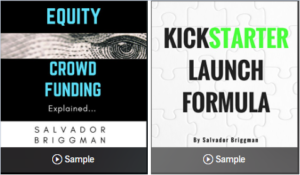WeFunder is one of the top equity crowdfunding websites out there that you can use to raise funds for your startup company.
Whether you have a software startup, a beverage company, a technology venture, or other types of growing business, you can use regulation crowdfunding (Reg CF) to get funding online for your startup.
In fact, we’ve seen historic growth in equity crowdfunding in the past year, and it’s only going to get BIGGER.
With the expansion of digital marketing, social media networks, and codified crowdfunding principles, this opportunity is ripe for the picking.
If you’re not familiar, I’ve covered this in my audiobook, Equity Crowdfunding Explained, which delivers the complete step-by-step blueprint for launching one of these projects
I go in-depth into the marketing strategy you need to succeed and a couple of key resources that you don’t want to miss out on.
That being said, let’s dive into today’s article, where we get in the trenches with what you have to do to hit it big on WeFunder or any other equity crowdfunding website.
1. It’s All About the Deal…
NO!
I’m not talking about your WeFunder campaign page, though that is equally as important (and we’ll get to that later).
I’m referring to the actual contract that investors will be using to participate in your Regulation CF offering.
At the end of the day, that’s all that financial security is. It’s a contract, which represents ownership in or an obligation that a startup company owes.
There are many different forms of offerings that you can make on WeFunder. We’ve compiled a list of them here.
You could have the best startup company in the world. You could be growing like crazy and join the hall of fame alongside Facebook and Google as a Unicorn.
But, if you’re offering the wrong deal, then no one is going to invest. They might check out the offering, but they won’t actually commit once they are on the page.
The deal is going to determine whether or not you convert investor attention into investor action.
Think it through and examine your valuation.
Is this a priced round, or are you offering future equity?
Is this a convertible note, or are you issuing debt?
Craft a careful deal, and make sure you announce it here.
2. Design a Page That Converts
You can have the best deal out there, but if your WeFunder page sucks, then all those eager investors are going to abandon the checkout process.
A great page will cover the major objections that will hold an investor back from taking action. It will also tell the story of the company, founder, and product.
Think of it as a pitch deck on steroids.
This sucker is going to turn any stone-cold visitor into an eager investor through the use of items like:
- Professional photography
- High-end imagery
- Attractive moving GIFs
- Copywriting that sells
- A cohesive story
If nothing else, you have to make sure that this oh-so-powerful page illustrates the massive market potential that your startup has.
But, ideally, it should do more than that.
I go through this in my free equity crowdfunding course and detail all of the specifics.
A standard page should include the following items, in no particular order:
- Headline that sizzles
- Market opportunity
- Problem/solution
- USP (unique selling proposition)
- Team and expertise
- Growth metrics
- Gifts (aka rewards)
- Social proof/credibility
- Business model
- Vision for the future
No joke, a great page is worth thousands of investor dollars, so either make sure that you get it done right or hire the professionals.
You can talk about your page in a one-on-one coaching call with me if you’d like to get some feedback.
There are also plenty of easy tricks that you can incorporate to make your content leap off the page, like including emojis, graphical headlines, fancy charts, and much more.
A page is not a static object.
It’s a dynamic marketing asset, like a website, which should be improved upon, changed around, and altered as you continue with your equity crowdfunding campaign.
3. Prep Your Crowd (or Else)
One of the concepts I pioneered in the industry in 2012 was the idea of a pre-launch. I documented this in my book, the Kickstarter Launch Formula, and continued this work with Equity Crowdfunding Explained.
It’s extremely important that you prep your crowd before going into a Reg CF campaign on WeFunder or other equity crowdfunding platforms.
If you fail to do this, you will launch and only hear…crickets.
Very few will visit your page, almost no one will invest, and you’ll be kicking yourself for not listening more closely to what I’m telling you right now.
You must warm up your base before announcing any kind of Reg CF campaign to them. You can do this through a strategic social media and secret marketing campaign that will deliberately raise their buying temperature.
The role of the pre-launch is to do the following:
- Arouse curiosity in prospective investors
- Address objections before they arrive at the page
- Raise their desire to participate in the round
- Give a feeling of exclusivity to prospective investors
- Ensure they take action right away when you launch
- Create social proof for your page
- And more…
Think of it as the best gosh darn way to make sure people show up at the party when you announce it.
NOW you see why I stress this so much and why so many of my coaching calls cover this valuable element of your WeFunder launch plan.
I would go so far as to say that prepping your crowd is the #1 reason behind mega success on WeFunder because it sets the foundation for the entire rest of the equity crowdfunding campaign!
If you fail to prep your crowd, it’s kind of like building a house with a shoddy foundation. You could have the nicest window treatments, light fixtures, and granite countertops, but the entire structure is not sound.
One day, that big boy is going to sink into the ground or collapse!
Not good.
4. Pick the Right Lead Investor
At the time of writing, you’re going to need a lead investor in order to launch a campaign on WeFunder. You’ll also need to go through a test-the-waters phase where a certain amount needs to be committed.
The decision regarding the lead investor is important for a few different reasons: It shows credibility, creates trust, and communicates pre-validation.
Basically, all of the other investors on WeFunder will be investing on the same terms as the designated lead investor. This creates a sense of trust because they are getting the same deal.
No right-minded investor would want to get a bad deal.
In addition, it communicates pre-validation and credibility because it means that other people in your network are vouching for you. They are not only saying nice things; they’re also putting their money where their mouth is.
Have you ever streamed a movie that everyone else is raving about?
Why?
Because…it’s been validated by others to be good!
This means that you don’t have to think as much when making a choice.
If you pick the right lead investor, then it’s going to dramatically elevate your equity crowdfunding campaign in the eyes of strangers. It will be easier for you to convert people who have never met you before into members of your investor community.
Wouldn’t it be great to do LESS work and have BETTER results?
That’s exactly why you want to be careful with your lead investor. Make sure that you pick someone who will elevate your brand and not bring it down.
Make sure they are investing enough to have some skin in the game. It sets the bar for what others might consider investing.
You will also want to round up a couple of early investors so that you can get out of the gate and be announced to the overall WeFunder community much sooner.
These individuals will not be lead investors, but they will lead the pack, so to speak, in showing others that you have genuine investor demand for your business.
This will happen in the test-the-waters phase and goes beyond the scope of this article.
5. Create a Media Firestorm
Launching a WeFunder campaign is a full-fledged event. It goes beyond just raising money for a startup.
It’s a historic event in the lifetime of a company.
This means that you’re going to want to pull out all the stops when it comes to getting the word out about your equity crowdfunding campaign.
There are many ways to go about doing this, but a basic Reg CF marketing strategy should include:
- Social media marketing
- PR pitching and press release outreach
- Influencer promotion
- Organic storytelling (IG/FB)
- Paid marketing campaign
- Internal marketing campaign
- News releases staggered throughout the launch
- And more…
You’ll want to think about the target markets that need to hear about this project in order to drum up investor interest.
Remember, whenever you’re doing a marketing campaign, traffic is almost always guaranteed. However, conversions are not.
You want to be working with partners who are relevant to your ask and have a foothold in the industry that you need to access to make this whole thing work.
Would you rather have 100 wealthy business owners on your page or 1,000 teenagers who can’t invest?
It’s not about numbers; it’s about the quality of the individual that you’re putting your message in front of, whether or not it resonates, and evaluating if they’d like to become a part of your success.
This is a great opportunity to work with other people in the crowdfunding industry to help get the word out about your project.
You can also test a few different approaches and see what kinds of results they contribute to your overall raise. Since you’ll be doing it over the course of 90 days or more, you have a little bit of time to work with.
6. Give Investors ACCESS to You
When I talk about marketing to my coaching students, sometimes they say that they want a campaign that runs on autopilot.
I agree—this is amazing and 100% possible.
However, it’s not a bad thing to involve a little bit of work in the investing process.
If joining a simple phone call led to a $10,000 investment, would you do it?
Exactly!
You’re going to want to give investors a way to access you in order to help make their decision. Some people will decide to invest in your Reg CF campaign right away, but others are going to need a little hand-holding.
I recommend setting up an investing process document that outlines the various ways that different categories of investors will be led to their investment decisions.
This is similar to setting up a sales process, which is common in all businesses.
That way, you won’t miss out on any larger investors just because they need a little bit more information from you before converting into an investor.
For example, you could set up a Calendly call system that will allow people to book a call with you if they want to get more information before investing.
Not only will this serve to nudge equity crowdfunding investors closer to action, but it will also give you the opportunity to hear some of the common investing objections.
You need to write down and understand the objections that you’ll need to help prospects overcome if you want to convert them into investors during your WeFunder campaign.
Another easy way to give the feeling of access is to actually be responsive to the investors who ask questions on the WeFunder campaign page.
A non-responsive team hurts the company’s image. It makes you seem like you don’t care.
Take the time to respond to questions and comments that you get on your page.
You’ll thank me later when other people who come to the page see this, and they come away thinking, “Wow, this team really cares!” Responding to comments is not always about the commenter. It’s also about the people who are reading those responses in the future and deciding whether or not to participate in your regulation crowdfunding round.
7. Come Up With Attractive Investor Perks
One of the great things about WeFunder is that you can offer exclusive perks (or gifts), which an investor can claim when they invest at a certain amount.
Think of this as rewarding those loyal investors who are taking a leap of faith by betting on your startup company. They’ll get access to a version of the product or other interesting gifts that could entice them to take action.
These work as a bonus of sorts.
They’re little extra freebies that sweeten the deal.
For example, I recently interviewed a WeFunder campaigner who launched multiple campaigns that racked up millions of dollars online. This was for a music-focused software app that empowers talent around the world.
The team decided to offer a limited-edition NFT (non-fungible token) for the first 400 investors who invested $500 or more. This was an exclusive gift and one of the world’s first NFT rewards on a crowdfunding platform.
The belief would be that the value of this NFT would increase over time as the popularity of the company increased. Thus, it could be a collector’s item that would have value in the future.
Not only that, but it would give a feeling of exclusivity for an investor to possess the intellectual rights to a digital asset that the company issued.
Now, that’s what I call a unique reward!
You don’t have to be this original when coming up with perks, rewards, or gifts tied to your WeFunder campaign. You can also offer services, products, and other items that may have value to the investor.
I think it’s also a great opportunity to involve investors in your actual product so that they can become evangelists for your brand in the long term.
If you need some help figuring this out, you can book a coaching call with me, and we can discuss your project in-depth.
Reg CF is seeing massive growth, and now is a killer time to get in on the industry! We’re seeing raises as we’ve never seen before (and in record time).
Keep doing your homework, and you’ll gear up to an epic launch that will get you a spot on my podcast as one of the up-and-coming entrepreneurs that everyone needs to know about.












